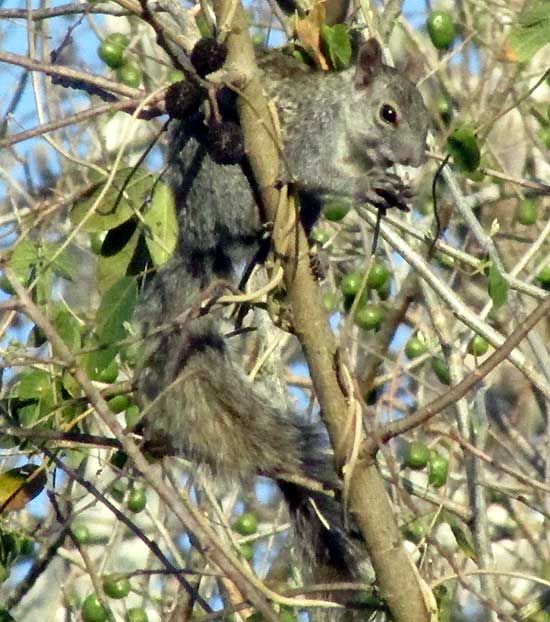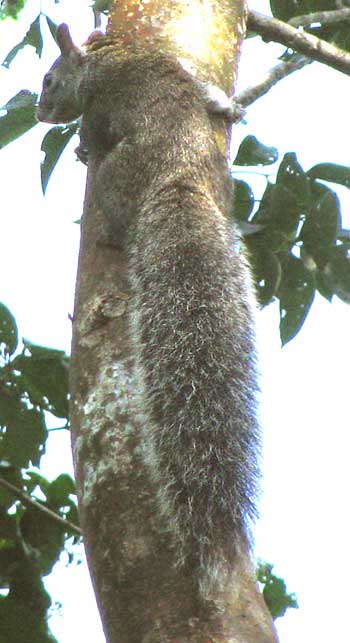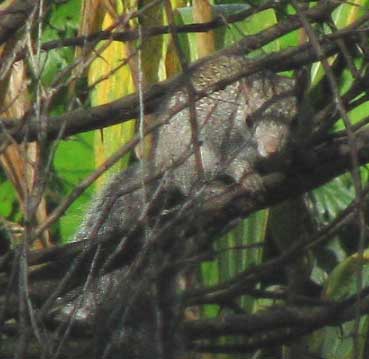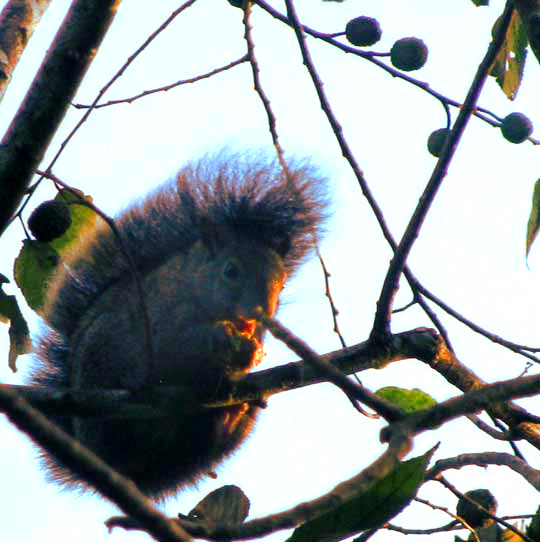Excerpts from Jim Conrad's
Naturalist Newsletter
Issued March 26, 2020 from the forest just west of Tepakán; elev. ~9m (~30 ft), N21.053°, W89.052°; north-central Yucatán state, MÉXICO
MORNING FEEDING
Most mornings two or three Yucatan Gray Squirrels feed near the hut as I have my granola. That's one below, eating black fruits of Guazuma ulmifolia.

from the November 29, 2009 Newsletter issued from Hacienda Chichen Resort beside Chichén Itzá Ruins, central Yucatán, MÉXICO; limestone bedrock, elevation ~39m (~128ft), ~N20.676°, ~W88.569°
SIX YUCATAN SQUIRRELS
Hacienda Chichén's owners try to protect their animals. I was impressed when on my first day here a gardener told me that here we don't kill snakes or other critters. Regularly filled water troughs are scattered all around the property. The efforts are paying off. The other day in a weedy clearing I saw three White-tailed Deer, which is something almost unheard of in the Yucatan. Most places I go in the Yucatan I see no deer at all, despite the scrubby, hacked-over vegetation providing perfect deer habitat. Throughout the Yucatan poaching is rampant and done out in the open. There are good laws but no enforcement.
Same for squirrels and rabbits. Therefore, this week I could hardly believe my eyes when SIX Yucatan Gray Squirrels, SCIURUS YUCATANENSIS, crossed my trail on an overhanging limb, one after another. A funny thing about the group was that most if not all of them every few seconds uttered a sound something like a fingernail making a half-second-long scratch on dry cardboard. For awhile I was surrounded by these skronky sounds and just had to laugh.
Surely this was the old story of a female being in heat, pursued by interested males. Such chases may last most of a day, may include resting periods, and theoretically toward the end of the chase one male after another starts dropping out until only one is left, and he gets the prize. In my online book "Mistletoe: One Year in The Life of An Eastern Gray Squirrel" I describe one such chase in detail here.
After crossing my trail they climbed up a Gumbo-limbo tree where I managed to photograph one. He's shown below:

Other Yucatan Squirrels I've seen always struck me as smaller than an Eastern Gray, but these were as large or larger. The tails were especially long and bushy.
Yucatan Gray Squirrels are endemic to the Yucatan, Tabasco, and Eastern Chiapas in Mexico, and northern Guatemala.
from the March 13, 2011 Newsletter issued from Hacienda Chichen Resort beside Chichén Itzá Ruins, central Yucatán, MÉXICO; limestone bedrock, elevation ~39m (~128ft), ~N20.676°, ~W88.569°
SQUIRRELS ON A CHASE
This week our endemic Yucatan Gray Squirrels have been putting on a show -- or rather a chase. You'd see maybe ten of them filing through the trees, jumping from one tree to another, as if playing follow-the- leader.
The leader was a female in heat and the followers were males with aspirations. It was a thing to see. Sometimes the female would come to the tip of a branch in a bad position for jumping to another tree, she'd turn around, chatter and look menacing, the guys behind her would stop, stare, and then retreat enough to allow her escape, and then the chase would start again. It was as if they all understood that it was a chase for the chase's sake, and that it wasn't really for anyone to be caught, at least not right now.
I've seen chases like this up north among Eastern Gray Squirrels. In fact, in my online book "Mistletoe: One Year in the Life of a Gray Squirrel," such a chase is described in Chapter Two, downloadable at www.backyardnature.net/mist02.htm.
In that chapter I describe behaviors witnessed among park squirrels in Centennial Park in Nashville, Tennessee, where I lived for some years. Our Yucatan squirrels do everything the Centennial Park ones did, including the males gnawing on bark the female had just run over leaving her scent. Something I saw one hormone-intoxicated male do here that no squirrel in Tennessee ever did, however, was to rush up to a big iguana sunbathing on a limb and apparently nip the iguana's tail, causing a great tail-swipe at the squirrel's head. Who knows what that was all about? Maybe the squirrel was just so frustrated he felt he had to nip something.
Usually the way it works is that the males least at their sexual peak and physical prowess drop out of the chase after a few hours, but the real machos stick with it until late in the day. By that time the few individuals remaining are tired and really psyched up. Maybe there has to be a fight or two among the remaining males. Then finally the last one remaining has the honor of mating.
from the December 30, 2005 Newsletter issued from Hacienda San Juan just east of Telchac Pueblo, northwestern Yucatán, MÉXICO
YUCATAN GRAY SQUIRREL
An awful scolding arose back where I'd just come from, sounding like an upset squirrel. People here had told me that we have squirrels but to me this didn't look much like squirrel territory and I wasn't sure whether to believe them. We have few trees of any reputable size here, except for a few next to buildings and wells.
I sneak back to where the fussing comes from, see some shaking weeds, and my binoculars reveal the smallest, palest gray squirrel I've ever seen. He's just sitting among head-high weeds in an abandoned citrus orchard with patches of 20-ft-high, acacia- like Guaje trees (Leucaena glauca) -- not much of a forest. I don't see much more of the squirrel other than its tiny size and its very pale grayness. However, its chattering would be at home in any oak- hickory forest up north.
Back at the hacienda I dig out Vladimir's FAUNA SILVESTRE DE MEXICO by A. Starker Leopold and learn that I've spotted a Yucatan Gray Squirrel, SCIURUS YUCATANENSIS, a species endemic to the Yucatan Peninsula. Leopold says that Mexico has ten species of gray squirrel.
I just wonder what squirrels eat here. Having seen gray squirrels in the US Southeast eat mushrooms and bird eggs, I wouldn't put it past the local species to eat oranges, cactus fruit and seeds from the Guaje trees, which right now are absolutely heavy with legumes looking like flattened string beans.
from the October 27, 2008 Newsletter issued from near Yokdzenot, central Yucatán, MÉXICO
elevation ~25m (~82 ft), N20.707°, W88.731°
SQUIRREL IN A CORNFIELD
Up a muddy trail near the cenote there's a weedy cornfield I visit frequently. I'm told that the rainy-season drought we experienced back at Sabacché caused a complete failure of this year's corn crop here, too, and it looks like this field has been abandoned because it wasn't worth harvesting.
Critters, however, seem to find enough to make them happy, even if an unshucked cob provides only one or two grains. I visit the field often because in early morning birds raid the standing, dun-colored stalks en masse.
Melodious Blackbirds, Yucatan Jays, Green Jays, Great-tailed Grackles, Golden-fronted Woodpeckers, Hooded Orioles and White-winged Doves all tear at shucks, tug and scratch. Sometimes other species who'd never get excited about a corn kernel also visit, maybe attracted by bugs stirred up by the foragers or maybe just to be part of the action. Most eye-catching among this group are the Turquoise-browed Motmots and Cinnamon Hummingbirds.
A fat, glossy-furred Yucatan Gray Squirrel, SCIURUS YUCATANENSIS, also often is there, looking just like a Gray Squirrel up north, except maybe smaller. Also, squirrels here are more skulking, not in the least trusting of any movement or unfamiliar sound. You can see this suspicious squirrel below.

from the January 22, 2012 Newsletter issued from Hacienda Chichen Resort beside Chichén Itzá Ruins, central Yucatán, MÉXICO; limestone bedrock, elevation ~39m (~128ft), ~N20.676°, ~W88.569°
HUNGRY SQUIRREL
Nowadays on most early mornings just as the sun breaks over the horizon an endemic Yucatan Gray Squirrel, SCIURUS YUCATANENSIS, climbs into a tree near the hut and perches awhile nibbling fruits, as shown below:

The tree he climbs is an abundant, almost-weedy species that in most of Mexico is called Guácima, though in Querétaro we knew it as Aquiche, and the Yucatán Maya call it Pixoy. It's Guazuma ulmifolia of the Cacao (Chocolate Tree) Family, the Sterculiaceae. Nowadays because of the dry season many Pixoys have lost nearly all their leaves, but their branches still bear abundant, marble-sized, semi-woody, bumpy-surfaced fruits. The tough fruits contain just enough sweet goo to entice anyone with a sweet tooth to gnaw into them, thus freeing the seeds for dispersal.
So, what's the story here? The story is the mere fact that a Yucatan Gray Squirrel is being documented eating fruits of Guazuma ulmifolia. Down here relatively little fieldwork has been done on most plants and animals, so such documentation is valuable to future ecologists and book writers trying to piece together the life histories of organisms found here.
To that future investigator... here it is!